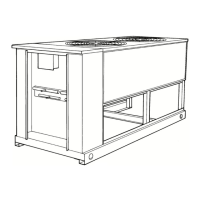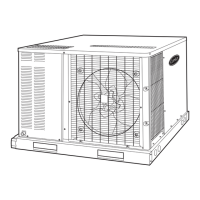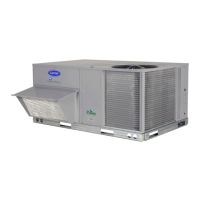21
SERVICE
Fan Guard Removal —
On all sizes, remove eight
1
/
4
x
14 x
5
/
8
-in. long self-tapping hex head screws per guard and
remove guard.
Fan Adjustment
1. Make certain condenser power is off.
2. Remove fan guard.
3. Remove cap and setscrews on fan hub.
4. Adjust fan. See Fig. 22.
5. Tighten fan hub securely on motor shaft with setscrew
which bears against the key.
6. Replace permagum and rubber cap over end of motor
shaft to prevent moisture from causing fan to rust on
shaft.
Lubrication — Fan motors have permanently lubricated
bearings. No provisions are made for lubrication.
Cleaning Standard Coils — Clean standard coils with
stiff brush, vacuum cleaner, or compressed air. Low-pressure
water may be used to clean coils by removing fan guard and
spraying coil from inside. Condenser fan motors are drip-proof
but not waterproof. Routine cleaning of coil surfaces is essen-
tial to minimize contamination build-up and remove harmful
residue. Inspect coils monthly and clean as required.
Cleaning and Maintaining E-Coated Coils —
Routine cleaning of condenser coil surfaces is essential to
maintain proper operation of the unit. Elimination of contami-
nation and removal of harmful residue will greatly increase the
life of the coil and extend the life of the unit. The following
maintenance and cleaning procedures are recommended as
part of the routine maintenance activities to extend the life of
the coil.
REMOVE SURFACE LOADED FIBERS — Debris such as
dirt and fibers on the surface of the coil should be removed
with a vacuum cleaner. If a vacuum cleaner is not available, a
soft brush may be used. The cleaning tool should be applied in
the direction of the fins. Coil surfaces can be easily damaged
(fin edges bent over) if the tool is applied across the fins.
NOTE: Use of a water stream, such as a garden hose,
against a surface loaded coil will drive the fibers and dirt
into the coil. This will make cleaning efforts more difficult.
Surface debris must be completely removed prior to using
low velocity clean water rinse.
PERIODIC CLEAN WATER RINSE — A periodic clean
water rinse is very beneficial for coils that are applied in
coastal or industrial environments. However, it is very impor-
tant that the water rinse is made with very low velocity water
stream to avoid damaging the fin edges. Monthly cleaning is
recommended.
ROUTINE CLEANING OF E-COATED COIL SUR-
FACES — Monthly cleaning with E-Coat Enzyme Coil
Cleaner is essential to extend the life of coils. It is recom-
mended that all coils including standard aluminum, pre-coated,
copper/copper, or E-coated coils be cleaned with the E-Coat
Enzyme Coil Cleaner as described below. Coil cleaning should
be part of the regularly scheduled maintenance procedures of
the unit to ensure long life of the coil. Failure to clean the coils
may result in reduced durability in the environment.
E-Coat Enzyme Coil Cleaner is non-bacterial, biodegrad-
able, and will not harm the coil or surrounding components
such as electrical wiring, painted metal surfaces, or insulation.
Use of non-recommended coil cleaners is strongly discouraged
since coil and unit durability could be affected.
The following field-supplied equipment is required for coil
cleaning:
•2
1
/
2
gallon garden sprayer
• water rinse with low velocity spray nozzle
Fig. 22 — Location of Propeller on Motor Shaft
from Outside of Orifice Ring
PROP LOCATION
“A” in. (mm)
Min Max
60 Hz
09DK020 3.12 (79.2) 3.38 (85.9)
09DK024,028,044 3.62 (91.9) 3.88 (98.6)
09DK034 Fan No. 1 and 3 3.62 (91.9) 3.88 (98.6)
Fan No. 2 3.12 (79.2) 3.38 (85.9)
50 Hz
09DK024,028,044 1.56 (39.6) 1.68 (42.7)
09DK034 Fan No. 1 and 3 3.12 (79.2) 3.38 (85.9)
Fan No. 2 3.62 (91.9) 3.88 (98.6)

